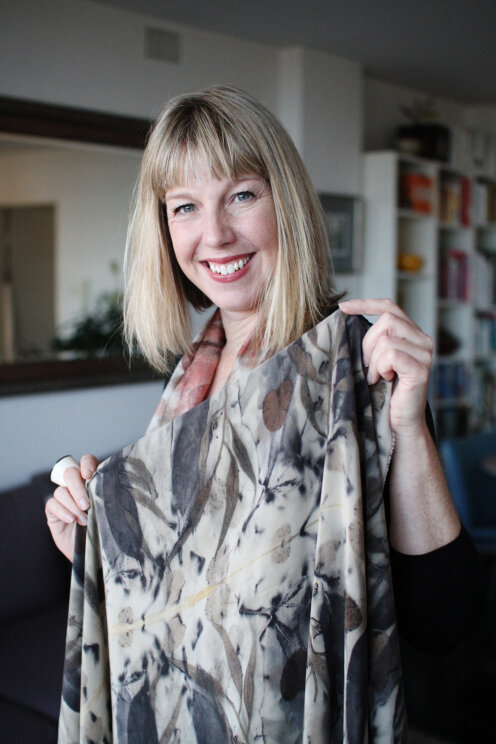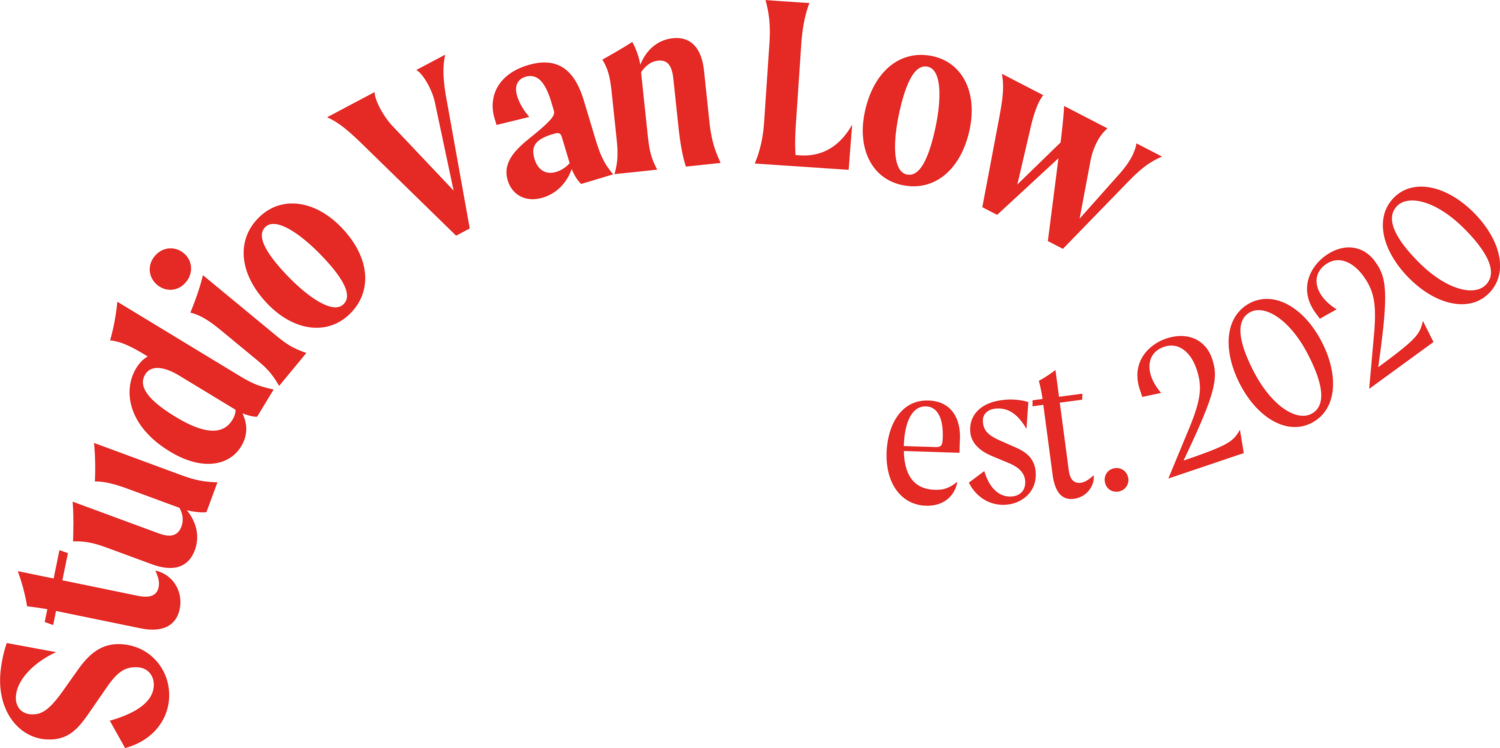Bee Bowen
Published on The Monday Issue, September 2014
Silk and wool are Bee Bowen‘s blank canvas, flowers and leaves her palette. Whilst having learnt various dyeing techniques in India and Japan, it is Bee’s use of local, Australian flora that create the distinctive patterns and colours of her textiles. The leaves and flowers picked by Bee leave detailed silhouettes and pigment when wrapped and boiled in silk or wool. Looking at her textiles, Bee is often able to tell the story behind the leaf that left its mark. Each of these imprints is unique, making each textile piece a narrative of place, season, and creative transformation. I interviewed Bee about her uncommon practice in anticipation of her involvement in the upcoming Cultivate – New Artisans exhibition (4- 14th October, 2014).
Vanessa Low: Fill in the blanks…
Bee Bowen: My name is (Bee Bowen), I am a (textile artist), from (Sydney). My art practice involves (capturing nature’s transient beauty in fabric). I am an artist because (I just want to make things! I have this inner urge to experiment and play, and create something unique and surprising)
VL: Could you briefly describe your background? How did you develop your interested in textiles?BB: Well, I’ve always been interested in textiles, as well as art, design, fashion and style. I’ve worked as an art director in advertising for about fifteen years now. So I’ve always had a creative job, which I loved. But I was ready for a blast of inspiration and a new challenge. So I went back to university to do a Masters at COFA [the College of Fine Arts, UNSW]
Through COFA I got an opportunity (and a grant) to go to India to study Artisan textile production. I was completely blown away by the abundance of talent in the most unexpected of places, the openness of the artisans, the hospitality of the people, the clashing colours and the general pandemonium. I loved it and returned nine months later craving more inspiration.
On my second trip I met an artisan, and I stayed with him for about two weeks and learnt about the process of dyeing and shibori (resist dyeing). The technique really appealed to me: the simplicity of folding twisting and binding the fabrics, the colours running into one another and fading into whites, all created unexpected and intricate patterns. Initially I watched and then joined in. He was extremely generous with his knowledge, time and dye pots. Consequently, I returned home with a suitcase full of scarves.
Back in Sydney, I applied my newly acquired knowledge to natural sources such as leaves, flora and veggies and discovered the wonderful world of natural dyeing.
VL: So, you went into textiles not knowing exactly what kind you wanted to do?
BB: No, I didn’t at all. But I was open and ready to engage with opportunities that came my way.
VL: What inspires your art-making process? Are there any particular people or artists or movements?
BB: Nature, of course. I’m fascinated by all the colours and patterns hidden in nature. Being half Danish, I’m drawn to unfussy Scandinavian design and appreciate the philosophy of quality and longevity. I’m also interested in supporting sustainable design and fashion.
My practice allows me to combine all this and create something that can actually help people connect with their environment.
VL: You have a range of dyeing processes, including food dyeing (using items such as blueberries, onions, red cabbage, and avocado) and botanical blemishes. Could you describe these two processes?
BB: When I dye with the food items I use shibori style – resist dyeing. I fold, clamp, or stitch and to create patterns, like stripes or circles. In this process, I extract colour by boiling up a pot of onion skins, red cabbage or avocado skins. Whereas for the Botanical Blemishes range, I arrange the flora directly on the silk or wool and bundle them up. Then I throw them in a pot. The heat then penetrates the fabric and transfers the plant pigment into the scarf.
VL: When you forage for the items for your botanical blemishes, what kinds do you look for?
BB: All sorts. But at the moment my favourite is grevillea. As I was walking back from getting my coffee this morning, they [points to a vase full of grevilleas] were just lying on the path; I think they’d just been blown down (stormy weather is great). I thought, “brilliant, I’ll have them!” I love eucalyptus. All eucalyptuses dye really well, the leaves are so tough and strong but create delicate shades of peachy orange, limes greens or moody charcoals. (I enjoy finding a long, beautifully-shaped leaf with big chunks missing – where some little bug has helped itself to a delicious lunch.) The ferns are also fab, packed full of vibrant green. Lavender is so fragile, although it’s a challenge to get the lilac hues, but the print is just the lovely. The fun part of this process is experimenting with different types of flora and seeing what comes out. Sometimes I just go for a walk around an area and take a bag with me and just pick sprigs of this, that, and the other.
VL: Could you explain how you then use the flora to create prints on the silk or wool?
BB: I carefully arrange the foraged flora into patterns on the fabric, I bundle them up and then put them in a pot of boiling water, or I steam them and leave them for two hours to twenty-four hours, sometimes even forty-eight hours. It’s a very organic process and even if I attempt to repeat the process with leaves from the exact same tree – it always turns out different – the season may have changed or it may have just rained or the leaves may be drier than last time. Unwrapping the bundles is the exciting part; it’s always a surprise… and usually a good one.
VL: You’ve lived in England, Denmark and Australia; and have travelled extensively in South America. What part of travelling do you enjoy the most?
BB: Travel is so invigorating – I’ve always had very itchy feet, and love discovering new places and meeting people. I’m extremely lucky to have been able to enjoy so much of the world and there’s still so much to see.
I’ve just been in Japan for six weeks. I went over to do a 10-day textile course on natural indigo and shibori with Canadian born textile artist Bryan Whitehead. It was wonderful. We were tucked away in the mountains and encouraged to play, with no distractions apart from delicious food. After completing the course and traveling around Japan for a few weeks I returned to Fujino to enjoy the tranquility and Bryan’s hospitality again. I set up a little area outside his house and explored my own natural dye practice there. And I ended up staying for another three weeks and could have quite easily stayed for longer amongst the maples and the mountains. Everyday I would collect leaves, shrubs and ferns whilst walking the slightly impatient dogs. It was fun to use Japanese leaves – they produced much lighter and brighter colours but it was also spring, which makes a difference, too.
VL: Something that I’m looking forward to is…
BB: Spring
VL: A question asked by the previous feature artist, Su-An Ng: If you were stranded on an island, what are the 3 things you would bring with you and why?
BB: I would hope that there would be lots of leaves on the island – so I would bring a big pot (hopefully I’d learn to make fire myself); a roll of silk; and my boyfriend, Sri, too.
-
Bee’s work will be on display at the upcoming exhibition ‘Cultivate – New Artisans’ at the Royal Botanic Gardens (4 -14 October, Palm House, Royal Botanic Gardens, Sydney. Free entry.)
-
Words and photography by Vanessa Low










